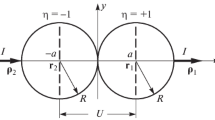Abstract
The conductivity of the two-dimensional Rayleigh model near a critical point, the percolation threshold, is investigated. The effective conductivity of the model with a metal–prefect conductor phase transition is calculated in the binary (pair) approximation. For the alternative model with a metal–insulator phase transition the corresponding effective conductivity is determined from the Keller–Dykhne reciprocity relation.
Similar content being viewed by others
REFERENCES
Lord Rayleigh, Philos. Mag. 34 (211), 481 (1892).
W. T. Perrins, D. B. McKenzie, and B. C. McPhedran, Proc. R. Soc. London, Ser. A 369, 207 (1979).
B. Ya. Balagurov and V. A. Kashin, J. Exp. Theor. Phys. 90, 850 (2000).
B. Ya. Balagurov, Electrophysical Properties Composites. Macroscopic Theory (URSS, Moscow, 2015) [in Russian].
B. Ya. Balagurov, Sov. Phys. JETP 67, 486 (1988).
B. Ya. Balagurov, Method of Eigenfunctions in Macroscopic Electrostatics (URSS, Moscow, 2016) [in Russian].
J. B. Keller, J. Math. Phys. 5, 548 (1964).
A. M. Dykhne, Sov. Phys. JETP 32, 63 (1970).
A. L. Efros and B. I. Shrlovskii, Phys. Status Solidi B 76, 475 (1976).
J. P. Straley, J. Phys. C 9, 783 (1976).
F. M. Morse and G. Feshbach, Methods of Theoretical Physics (McGraw-Hill, New York, 1953; Inostrannaya Literatura, Moscow, 1960), Vol. 2.
ACKNOWLEDGMENTS
In conclusion I express my gratitude to D.A. Golovneva and N.A. Khlopotunova for their help in preparing the manuscript of the paper for publication.
Author information
Authors and Affiliations
Corresponding author
Additional information
Translated by V. Astakhov
APPENDIX
APPENDIX
Knowing the complete system of eigenfunctions also allows other problems related to the inclusion under consideration—a macroscopic body, for example, about its dipole polarizability, to be solved.
In the case of a body placed in a uniform electric field of strength E0, the corresponding potential has the following asymptotics (at D = 2):
Here,
is the dipole moment and \(\hat {\Lambda }\) is the dipole polarizability tensor. According to [5, 6], for the components of this tensor we have
where dν is an analog of the dipole moment in the asymptotics of the polarization eigenfunction:
In Eq. (A.3)h = ε2/ε1 is the ratio of the permittivities for the body and the surrounding medium. For the pair of circles under consideration the functions \(\psi _{{2n}}^{{(e)}}\)(r) and \(\psi _{{1n}}^{{(e)}}\)(r) have a dipole behavior when r → ∞. For the corresponding dipole moments we have
For the components of the polarizability tensor \(\hat {\Lambda }\) we obtain
Note that Eqs. (A.6) and (A.7) satisfy the equalities
which are a corollary of the reciprocity relation (see [4]).
Rights and permissions
About this article
Cite this article
Balagurov, B.Y. Conductivity of the Two-Dimensional Rayleigh Model Near the Percolation Threshold: A Subthreshold Region of Concentrations. J. Exp. Theor. Phys. 130, 562–570 (2020). https://doi.org/10.1134/S1063776120020016
Received:
Revised:
Accepted:
Published:
Issue Date:
DOI: https://doi.org/10.1134/S1063776120020016




